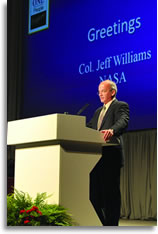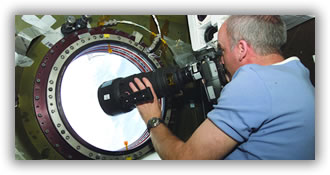by Sandy Wood
 |
|
Col. Williams greeting the delegates of the 64th Regular Convention of the LCMS in Houston.Photo courtesy LCMS/
|
Jeffrey N. Williams
Age: 52
Church: Gloria Dei Lutheran, Houston, Texas
Family: Wife Anna-Marie; adult sons Brad and Jason
Hometown: Born in Superior, Wis.; Raised in Winter, Wis., on a dairy farm that his grandfather carved out of the woods after emigrating from Sweden.
Education: U.S. Military Academy; U.S. Naval Postgraduate School; U.S. Naval War College
Military: Served more than 27 years in the U.S. Army. Retired colonel.
‘The heavens declare the glory of God; the skies proclaim the work of His hands’
(Psalm 19:1 NIV)
Gaze at the stars scattered across the night sky, or at the layers of cumulus floating through powder-blue day-light, and it’s easy to feel David’s praise in Psalm 19. From the Earth, words can scarcely capture the glory.
But from the heavens themselves, a man of God and a man of science brings a witness to God’s glory and grace and further testimony to Scriptures through an extraordinary perspective: the windows of his spacecraft.
Colonel Jeffrey Williams—husband, father, grandfather, and astronaut—most recently brought offical greetings to the delegates of the 2010 convention in Houston. He has also flown three missions into space. On two of them he spent months at the International Space Station.
Reflecting on God’s creation from orbit, “as a recipient of God’s grace, it’s a humbling thing,” Williams says.
“The more we grow in an understanding of God’s grace . . . the fact that He loved us enough to pay the price that He did is a tremendous, humbling significance.
“To view the Earth from space just magnifies all of that in the context of the Creator.”
 |
With all tasks accomplished, Col. Williams spends a final moment taking in the view.Photo courtesy of the Image Science & Analysis Laboratory, NASA Johnson Space Center. It can be accessed on The gateway to Astronaut Photography of Earth Web site at http://eol.jsc.nasa.gov/. |
Williams became an astronaut in 1996. He flew a 10-day mission on the space shuttle in 2000. In 2006, he was a member of Expedition 13, which took him to the International Space Station for six months. And in March, as he dropped into Kazakhstan at sunrise, he ended his third flight, which included nearly six months on the space station.
The International Space Station orbits Earth every 90 minutes, passing 16 sunrises and 16 sunsets every 24 hours. And with each orbit, Earth rotates a little more than 22 degrees, so Williams got a view of a different part of the planet each time around.
Expedition 13, his 2006 mission, orbited the Earth more than 2,800 times. During those spins, Williams took more photographs of Earth than any other astronaut.
Photographs from that flight make up his new book, The Work of His Hands: A View of God’s Creation from Space, published by Concordia Publishing House.
 |
|
Those photographs provide not only documentation useful for scientists but lessons about the order of the universe, God’s provisions for us, and “a new significance to the truth of many familiar biblical texts,” Williams writes.
“There is a fascinating passage in the Old Testament Book of Job that I have marveled at for years and now has special significance to me,” he writes.
“It speaks of God’s greatness manifested in His creation. . . . Any space traveler who has seen the Earth from orbit completely understands this sentence from Job: ‘[God] stretches out the north over the void and hangs the earth on nothing’ (Job 26:7 ESV).
“God really does suspend the Earth on nothing!”
While it sounds glamorous to go to space, and it is, it’s hard to be away from family, Williams says. He left on his last mission two days after his grandson, Braeden, was born.
It’s also tough for family to face certain life events alone. “But going through those experiences just grows our trust and confidence in the faithful provision that comes from our Lord,” Williams says.
“Oftentimes we don’t see that until after the fact. We have a duty to trust in it and then acknowledge it and see it. That grows our sense of trust in Him, our sense of contentment, grows our biblical definition of joy. Transcending all of that, it grows our gratitude in our gracious God, in all the ways grace is manifested.”
Part of that gratitude is being privileged to witness that perspective, Williams says. And sharing the experience, he finds, is the biggest reward of his work.
As part of that witness, he continued to shoot photos on his mission that ended in March, taking more photo-graphs—about 100,000—than ever before.
He’ll have time to see what those photos of Earth and space say to him as he awaits the birth of his granddaughter in September. It’s likely the photos will speak more about God as creator and provider.
But creation “does not even begin to reveal who He is . . .,” Williams writes in his book. “He is only fully revealed in His Word.”
Psalm 19 is one of Williams’ favorite Scripture verses: “The law of the Lord is perfect, reviving the soul. The statutes of the Lord are trustworthy, making wise the simple” (19:7 NIV).
—
About the Author: A veteran reporter and editor, Sandy Wood is a member of Chapel of the Cross Lutheran Church, St. Louis, Mo.





